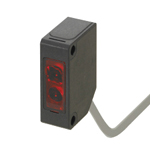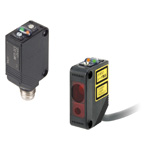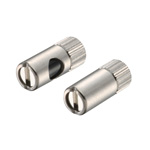(!)NOTE : Windows 7 users won’t be able to use some latest features of eCatalog/WOS since Microsoft is ending support for Windows 7 on 14 Jan, 2020. Please upgrade your system for uninterrupted services.
- Notice of End of Sales for Economy Series Pneumatic Equipment Category. More information.
Photoelectric Sensors, Fiber Sensors
Search by specifying the lower class category
 Photoelectric Sensors
Photoelectric Sensors Laser Sensor
Laser Sensor Fiber Units
Fiber Units Fiber Sensors (Amplifiers)
Fiber Sensors (Amplifiers) Lens for Sensor (for Photoelectric Sensors and Fiber Sensors)
Lens for Sensor (for Photoelectric Sensors and Fiber Sensors)
Brand |
|
|---|---|
| CAD |
|
| Days to Ship |
|
1 items
- Sort By
-
You can add up to 6 items per a category to the compare list.
![Ultra Compact and Slim Photoelectric Sensor With Built-in Amplifier [E3T]](//in.misumi-ec.com/linked/material/mech/OMR1/PHOTO/OMR1_221000398364.jpg?$product_view_b$)
Ultra Compact and Slim Photoelectric Sensor With Built-in Amplifier [E3T]
OMRON
Enhanced built-up of
[Features]
· E3T series photoelectric sensor with built-in amplifier, contributing to miniaturization design of equipment, the installation is made more simple and smooth.
· Lining-up of transmissive long-distance 2 m type E3T-ST3□).
· Easy installation with M3-mounting type (form E3T-ST□□M, form E3T-FD□□M, form E3T-SL□□IM) small cylindrical type with 1 point mounting (form E3T-C□□□(S))Detection Distance(mm) Type Detection Type Light Axis Arrangement Type Head Shape Detection Light Type Detection Object Amplifier Installation Type Detection Light Color Head Material Detection distance 【classification】(mm) Operating Environment Protection Structure Amplifier Function (Selectable only when Amplifier is installed) Fiber Type (Selectable only when Amplifier is not installed) Fiber clothing material Fiber minimum bend R(mm) 3~50 Photoelectric Sensor Reflection - Screw - Colored Surface Built-in Type Infrared - - - IP65 - - - - From: ₹ 8,497.00 Days to Ship: 5 Day(s) or more  5 Day(s) or more
5 Day(s) or more
| Brand |
|---|
| Product Series |
| From |
| Days to Ship |
| Detection Distance(mm) |
| Type |
| Detection Type |
| Light Axis Arrangement Type |
| Head Shape |
| Detection Light Type |
| Detection Object |
| Amplifier Installation Type |
| Detection Light Color |
| Head Material |
| Detection distance 【classification】(mm) |
| Operating Environment |
| Protection Structure |
| Amplifier Function (Selectable only when Amplifier is installed) |
| Fiber Type (Selectable only when Amplifier is not installed) |
| Fiber clothing material |
| Fiber minimum bend R(mm) |
You can add up to 6 items per a category to the compare list. | |
| Brand | OMRON |
| Product Series | Ultra Compact and Slim Photoelectric Sensor With Built-in Amplifier [E3T] |
| From | ₹ 8,497.00 |
| Days to Ship | 5 Day(s) or more |
| Detection Distance(mm) | 3~50 |
| Type | Photoelectric Sensor |
| Detection Type | Reflection |
| Light Axis Arrangement Type | - |
| Head Shape | Screw |
| Detection Light Type | - |
| Detection Object | Colored Surface |
| Amplifier Installation Type | Built-in Type |
| Detection Light Color | Infrared |
| Head Material | - |
| Detection distance 【classification】(mm) | - |
| Operating Environment | - |
| Protection Structure | IP65 |
| Amplifier Function (Selectable only when Amplifier is installed) | - |
| Fiber Type (Selectable only when Amplifier is not installed) | - |
| Fiber clothing material | - |
| Fiber minimum bend R(mm) | - |
Loading...
Configure
Specification/Dimensions
-
Detection Distance(mm)
- 0-3M
- 0~15
- 0.1-3m
- 0.1-2.5m
- 1,000
- 1~15
- 1~30
- 2~6
- 3~50
- 5
- 5~15
- 5~30
- 5.4~9
- 6
- 8
- 8~20
- 10
- 10~20
- 10~250
- 12
- 12~30
- 15m
- 15~38
- 16
- 17
- 20~100mm
- 27
- 30
- 30±3
- 30~200
- 30~700
- 35~200mm
- 50
- 60
- 100
- 100mm
- 110
- 120
- 130
- 140
- 150
- 150~1500
- 180
- 190
- 200
- 250
- 280
- 300
- 300mm
- 350
- 360
- 400
- 450
- 500
- 550
- 600
- 680
- 800
- 900
- 1000
- 1100
- 1200
- 1350
- 1500
- 1550
- 1700
- 1780
- 1800
- 2000
- 2000mm
- 2600
- 2700
- 2800
- 3500
- 3800
- 4000
- 5000
- 20000
The detecting distance can vary with your amplifier, operating environment and the detected object.
-
Type
- Photoelectric Sensor
- Laser Sensor
- Fiber Unit
- Fiber Sensor (Amplifier)
- Lens for Sensor
- Fiber Optic Sensor
-
Detection Type
- Transparent
- Reflection
- Liquid Surface Contact
- Recurrent Reflection
-
Light Axis Arrangement Type
- Emitting and Receiving Sections Integrated, Single
- Emitting and Receiving Sections Integrated, Reflection Plate Used
- Emitting and Receiving Sections Separated
-
Head Shape
-
Detection Light Type
-
Detection Object
- Colored Surface
- Transparent Body
- Small Area
- Liquid Surface (Pipe Mounting)
- Liquid Surface (Contacting)
- Wafer Mapping
- Label
-
Amplifier Installation Type
- Built-in Type
- Separated Type
- Amplifier Only
-
Detection Light Color
-
Head Material
-
Detection distance 【classification】(mm)
- ~10
- ~20
- ~30
- ~50
- ~100
- ~200
- ~300
- ~400
- ~500
- ~1000
- ~2000
- ~3000
- ~4000
- ~5000
- ~10000
- More than 10000
* ~20 represents over 10, and 20 or less.
-
Operating Environment
-
Protection Structure
-
Amplifier Function (Selectable only when Amplifier is installed)
-
Fiber Type (Selectable only when Amplifier is not installed)
-
Fiber clothing material
-
Fiber minimum bend R(mm)
Related Categories to Photoelectric Sensors, Fiber Sensors
FAQ Photoelectric Sensors, Fiber Sensors
- Question: What is the main advantage of using photoelectric sensors in industrial applications?
- Answer: Photoelectric sensors offer a significant advantage in industrial settings due to their non-contact detection capability. This feature eliminates the need for physical contact with the target object, reducing wear and tear and enabling reliable, long-term operation. Their quick response time is crucial for applications requiring rapid detection, contributing to increased efficiency in various industrial processes.
- Question: How do I choose the right photoelectric sensor?
- Answer: Selecting the appropriate photoelectric sensor involves considering several factors. Evaluate the sensing distance required for your application, environmental conditions, such as ambient light and temperature, and the characteristics of the target objects. Differentiate between through-beam, reflective, and retroreflective sensors based on the specific needs of your application.
- Question: Can these sensors be used in outdoor environments?
- Answer: Some photoelectric sensors are designed for outdoor use. It's essential to choose sensors with suitable Ingress Protection (IP) ratings to ensure they can withstand exposure to weather elements and maintain reliable performance.
- Question: What is the difference between a through-beam sensor and a reflective sensor?
- Answer: Through-beam sensors consist of separate emitter and receiver units, with the light beam traveling from one unit to the other. In contrast, reflective sensors integrate both the emitter and receiver in the same housing, detecting the light reflected off a target object.
- Question: Can photoelectric sensors detect transparent or highly reflective objects?
- Answer: Certain photoelectric sensors are specifically engineered to detect transparent or highly reflective objects. Choosing sensors with the appropriate technology, such as background suppression or polarization filters, ensures accurate detection in challenging conditions.
- Question: What maintenance do photoelectric sensors require?
- Answer: Photoelectric sensors typically demand minimal maintenance. Regularly cleaning the sensor lens to prevent the accumulation of dust or dirt is recommended to ensure consistent and accurate performance over time.
- Question: Are there any safety considerations when using photoelectric sensors?
- Answer: When using photoelectric sensors, it's crucial to ensure compliance with relevant safety standards. Installation should follow the manufacturer's guidelines, and users should be aware of the sensor's limitations. For critical applications, incorporating redundancy or additional safety measures is advisable to mitigate potential risks.
- Question: What are the advantages of fiber optic sensors?
- Answer: Fiber optic sensors offer several advantages over traditional sensors, including:
Long distance operation: They can transmit signals over long distances without significant signal degradation.
Compact and lightweight: They are small and lightweight, making them easy to install in tight spaces.
Low power consumption: They require very little power to operate.
High immunity to electromagnetic interference (EMI): They are not affected by electrical noise.
Versatility: They can be used to measure a wide range of parameters.





![Ultra Compact and Slim Photoelectric Sensor With Built-in Amplifier [E3T]](http://in.misumi-ec.com/linked/material/mech/OMR1/PHOTO/OMR1_221000398364.jpg?$product_view_b$)
![Ultra Compact and Slim Photoelectric Sensor With Built-in Amplifier [E3T]](http://in.misumi-ec.com/linked/material/mech/OMR1/PHOTO/OMR1_221000398364.jpg?$product_view_c$)













How can we improve?
How can we improve?
Thank you for your time.
Your feedback is essential for our continuous improvement
Privacy Policy
Thank you for your cooperation.
Thank you for your time.
Your feedback is essential for our continuous improvement
Please use the inquiry form.
Privacy Policy